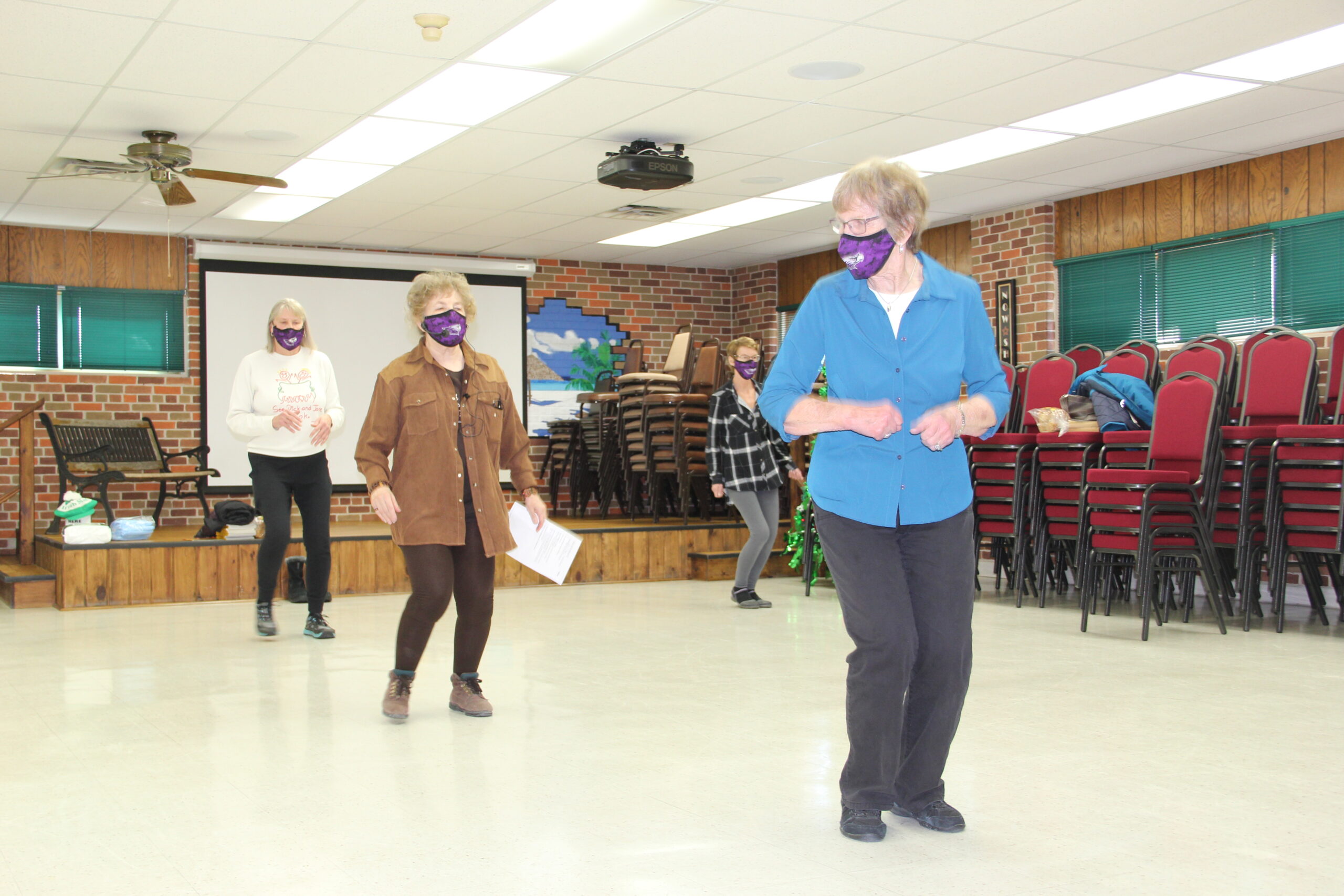By Chris Spangler
Contributor
Right, left, step and turn, toe-heel, toe-heel.
Right, left, step and turn, toe-heel, toe-heel.
Quarter-touch, right-touch, back-touch, left-touch.
Right-together-right, and left-together-left …
It’s Friday afternoon and three women are learning how to line dance at the Fort Atkinson Senior Center. There are a few missteps (and laughs) at first, but it doesn’t take long before they’ve mastered the moves.
The class is just one of several that resumed last July when the Robert Street venue reopened after a four-month closure due to the coronavirus pandemic.
Wearing facemasks, sanitizing their hands and staying at least six feet apart, the dancers say they feel safe at the center due to class-size limits and other safety measures put into place. However, attendance at all events currently is about two-thirds lower than during pre-COVID times.
“Here in Fort Atkinson, we started this class again in August,” teacher Nancy Wrensch of Jefferson explained. “We used to have a minimum of five students, but … there are several out who are afraid of COVID and a couple have jobs taking care of other people and don’t want to take a chance. We have one woman who lives at Reena (Assisted Living) and if they have an outbreak, she is quarantined.
“So, it’s a smaller class than it used to be,” she added.
Senior center director Chris Nye said that continues to be the rule rather than the exception as the pandemic nears its first anniversary.
“Everything really shut down all at once the week of St. Patrick’s Day,” Nye recalled of March 17, 2020, the day public spaces closed their doors and turned out the lights.
The senior center still tried to stay connected with folks, though. In May, it started Puzzle Tuesdays, a weekly drive-through jigsaw puzzle exchange that proved popular.
“People could request two 500-piece puzzles with landscape or scenery or what have you,” Nye said as an example. “We have lots of puzzles here, so there was no sense in having all these puzzles sitting in a building that is empty when people could be doing them. And at the time, people were desperate for something to do.
“I think it went pretty well,” he continued. “We had several people coming each week and they were dropping off puzzles, they were picking up puzzles; we had some people who had a bunch of puzzles that they wanted to donate to us.”
In July, the center reopened its doors, albeit with COVID-19 precautions, including mask wearing, hand sanitizing, social distancing and limiting the number of people in rooms at one time.
“We kept it at 10 people max in a room. We have a fairly good-sized building, so it was kind of hard to come to a number,” Nye said, explaining that placing a limit of, say, 25 percent would not have been logical.
“It didn’t make any sense to figure it out that way because realistically, this building would have a capacity of maybe 500 people,” he noted. “It would be ridiculous to say ‘we’re going to do 25-percent capacity.’ That would be 125 people.”
The 10-persons-per-room ceiling has worked well.
“Not to toot our own horn too much, but it’s a year into this pandemic … and of the months that we’ve been open, we haven’t had any contact tracing that ever said that anyone in this building had the virus and gave it to somebody else,” Nye said.
“We’ve had a couple times where somebody has had the virus and has been in this building, but nobody has gotten it from them,” he added.
Nye said that people are people and periodically they take a few steps closer to each other than advised. That particularly can be the case for those with hearing difficulties.
“But by and large, we’ve been able to do this very successfully,” Nye said.
He acknowledged that there were some skeptics when it was decided to reopen the senior center last July.
“There were some comments out there, like ‘you guys are a senior center and that’s the population that’s going to get hit the hardest, so why are you open?’” Nye recalled.
However, he said, he felt strongly that physical health was not the only thing to consider.
“My philosophy was, and I maintain it to this day, there was a huge mental health aspect going on with this population of people — the 60 and older, 55 and older, or wherever you want to put your breaking point of where a senior citizen starts,” Nye said. “These people were all at home, and they weren’t getting out; they weren’t getting anywhere. The grocery store was maybe their big outing.
“In my mind, there was more of a need for them to see other people and do something out of their house than there was a risk to them getting sick and having major health issues,” he added. “I think it’s played out that way over time. We were able to do this safely.”
Visitor feedback has borne that out, as well.
“It’s been stated by several of them that, yeah, this was huge,” Nye said. “To be able to come in and watch a movie, even if they’re just sitting at their own table and there are five other people in the room. At least they are able to sit there and interact a little bit and get out of the house.”
And then there are the classes such as Strong Women, Gentle Yoga and Line Dancing.
Gentle Yoga formerly had 24-25 people pre-COVID. Since it restarted, there are eight or nine.
Strong Women has witnessed similar attendance. About 10 people attend in person, but others take advantage of following the movements at home via text.
“Yes, they’re wearing masks and it is different because they’re focusing on breathing …, but they do it. The ones that have been there from July 6th on will tell you that this was a huge thing for them,” Nye said.
Movement and social interaction, even six-plus feet away from each other, has helped fend off cabin fever.
“For some people, that was the only time they were going anywhere other than the grocery store,” Nye said. “So, it was important we gave them a safe outlet to go to, and really, truly, we have continued to give them a safe outlet to go to.”
He said that he knows of other Wisconsin senior centers that remain closed after nearly a year.
“I just think that there are some people who are really struggling with that,” Nye said. “They were attending something at their center on a regular basis and now they haven’t for a year. What are they filling that void with? Where else are they going where they feel any safer?
“I think we’ve done the right thing.”
Not all activities have returned to the Fort Atkinson Senior Center, though, among them the popular dartball and card games.
“It was obvious it would be difficult to justify how we could have a card game where everyone’s touching the same cards and can’t sit six feet away from each other,” Nye said.
Now, with more and more people becoming vaccinated against COVID-19, the question becomes: at what point does the senior center loosen restrictions?
“I’m not at the point of opening the card games because I don’t want to restrict someone who has been trying to get the vaccine, but can’t yet,” Nye said.
There have been suggestions to restart card games and require players to show their vaccine card.
“I kind of cringe on that because I don’t want to exclude people,” the center director said. “I would rather get to a point where I feel it’s safe to do these things again knowing that if people wanted the vaccine, they had the chance to get it; they know that if someone is coming in to play cards and they didn’t get the vaccine, it was their choice to not get it and … they are choosing to come in and play cards anyway.
“The onus is on them.”
Nye said that he has done some impromptu polls, asking center attendees for a show of hands of who has been vaccinated. About half of those coming in for bingo, trivia contests, movies and the like have had at least their first COVID-19 shot.
“This isn’t a scientific poll by any means; … but I think you can kind of surmise that close to half of our population of older adults have probably had at least one of the vaccines and I know there are others I’ve talked to who haven’t been able to get in to get it yet for whatever reason, but they’re still trying,” Nye said. “I think most will eventually get the vaccine in the next several weeks.”
Then it will be time to take another look at resuming card games, dartball and other such activities. In fact, some of the dartball league members are thinking that May might be a potential date.
But whenever it is, all of the safety precautions will continue to be required.
There also are the large gatherings to consider. Nye said that holiday parties, potlucks and monthly musicians draw 80 to 90 people. The Jefferson County Nutrition Center lunches attract 15 to 20 people a day.
“Pick-up to-go meals have been pretty well received,” Nye said of the nutrition center lunches that have been distributed in the parking lot during the pandemic. “There was a demand there, and for some, there was a need. It was a good thing.”
The desire to play bingo also has been on the rise. Nye said he considers the entertainment and dining rooms separate spaces, essentially doubling the size limit for players.
“I’ll let 18 people out there and they still are six feet apart,” Nye said of the bingo players. “There are 12 or 13 tables, some with doubles of couples coming together. Bingo has gotten totally booked up and we have extra people trying to get in.”
The center director said that as more people are vaccinated and the coronavirus spread continues to decline, he expects to see attendance at all activities increase.
“The challenge, of course, of all of this is that whole balancing act of what do we go to next?” he explained. “Do we start allowing 15 people in a room? How do we grow It without doing it too soon? There’s still some balancing to do in the next two weeks where it’s that pivotal point.”
However, that is a good challenge to have, for it means life might be getting closer to “normal.”
“In hindsight, it’s been such a weird year,” Nye said. “When we closed, and even when we reopened, … it boiled down to ‘how can we do the most we can do, but do it safely for people?’ And in the back of your mind, you keep thinking, ‘if we can get through this thing and, when all is said and done, we can look around and say we didn’t lose many people we knew to this virus,’ I think we’d feel pretty good about it.”
Unfortunately, one regular local senior center attendee did pass away from COVID-19.
“It is sad because it would have been great to have gotten through this without losing anyone,” Nye said. “I know of others who have had it and were not very good, but they’re here; they recovered.”
Meanwhile, Nye said that he believes the Fort Atkinson Senior Center remains one of the best-kept secrets in town. That likely is, in part, because many Baby Boomers think it is for “old people.”
“We’ve got something here for everybody …. 55 to 60 years old, you’ll find something you’ll enjoy to do here, just as people who are 85, 90 and above will, as well,” Nye said, noting that the average age is close to 70. “We try to offer a variety of things.
“It’s a nice mixture and a good challenge to have,” he added. “People in their 60s are looking for things that are different than people in their 90s. There’s something for everybody … whether it’s a movie or bingo or fitness classes.
“Line dancing is a fitness class, but it’s more about having fun and learning something new.”
Something new?
How about: Cross, side, right; recover, cha-cha-cha.
Half-turn, cha-cha-cha. Quarter-turn, cha-cha-cha?
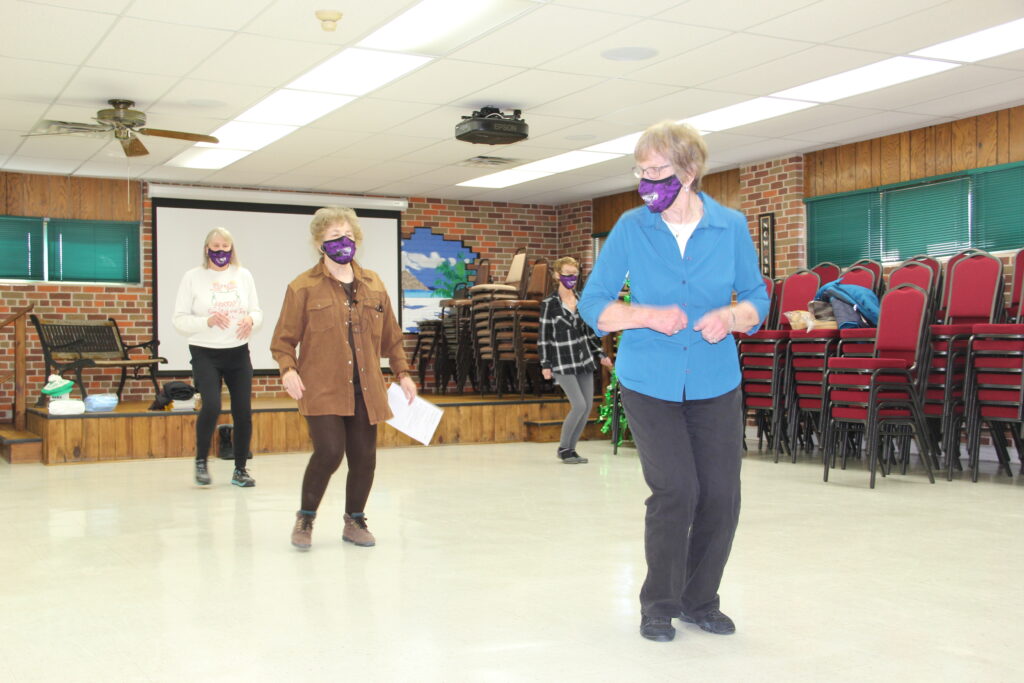
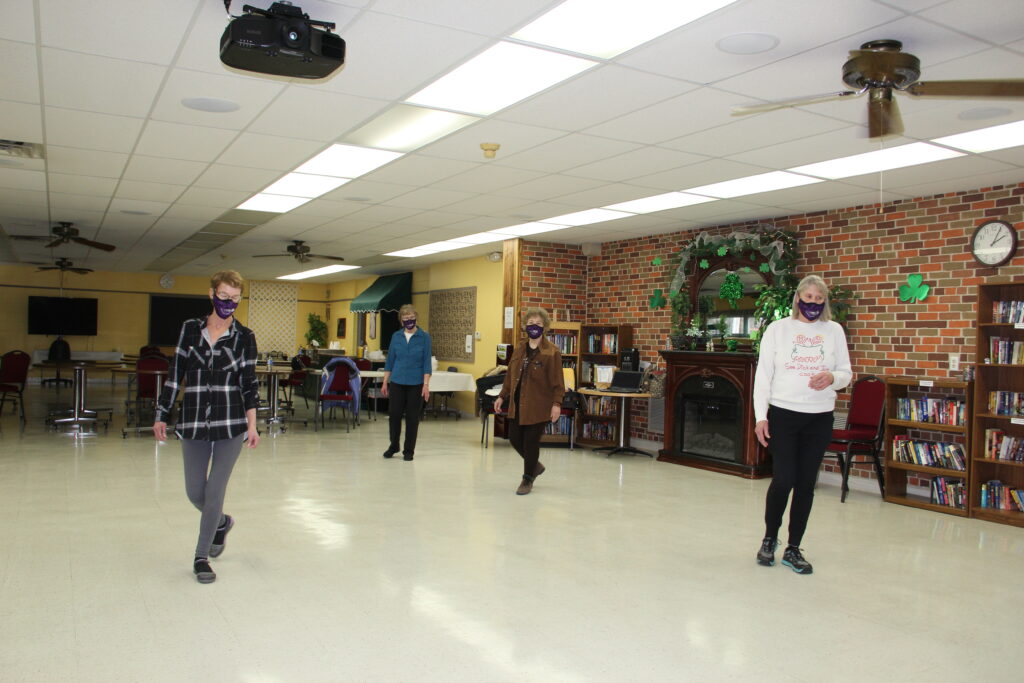
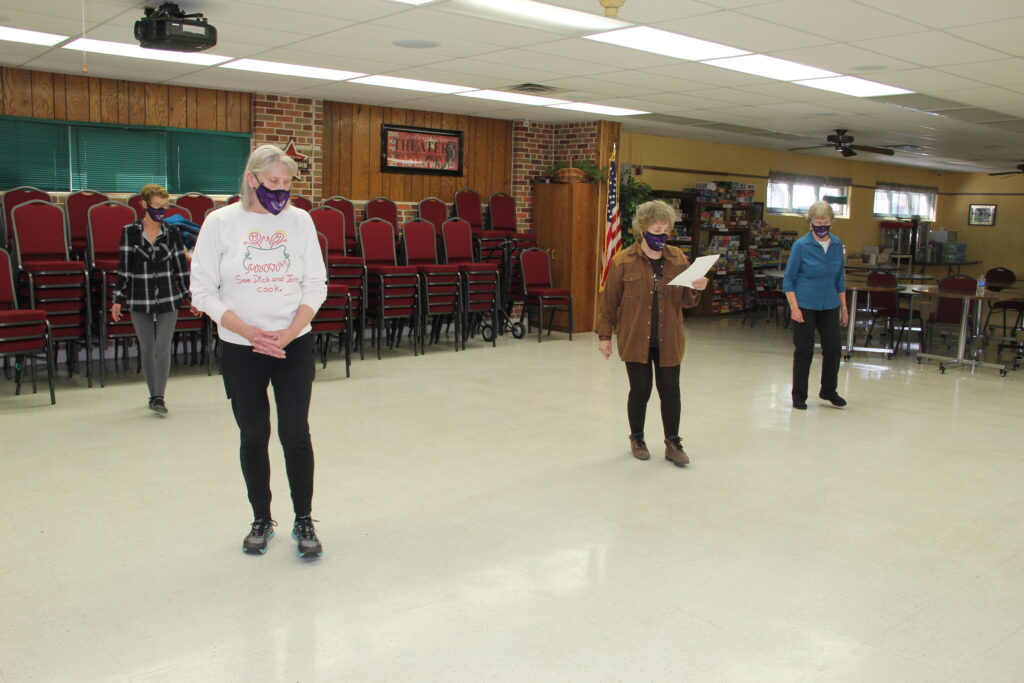
Above three photos: The Fort Atkinson Senior Center reopened last July with limited class sizes after being closed entirely for four months due to the COVID-19 pandemic. A Friday line dancing class usually draws about six students, although only three were on hand for a recent session. The teacher is Nancy Wrensch, Jefferson, shown in brown. Dancers are Janie Anderson, Whitewater, in white; Cindy Weber, Fort Atkinson, in plaid; and Cathy Deichl, Fort Atkinson, in blue.
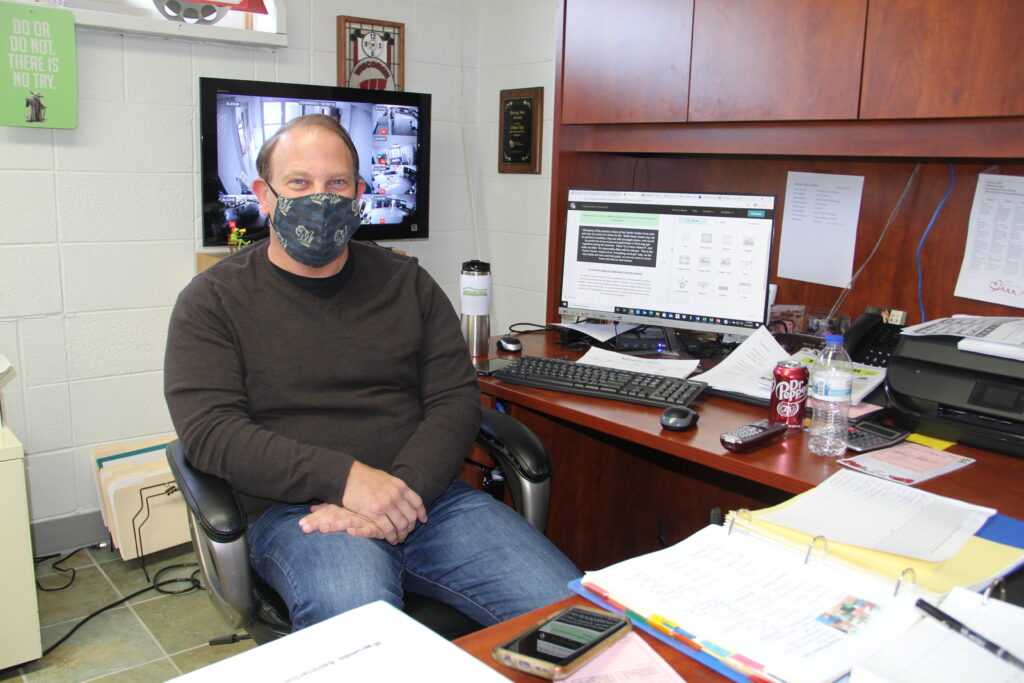
Chris Nye, director of the Fort Atkinson Senior Center, says he is looking forward to when he can reopen the facility to unlimited attendance. The center closed March 17, 2020, due to the coronavirus pandemic, reopening in July for limited access.
Chris Spangler photos.
This post has already been read 2257 times!
